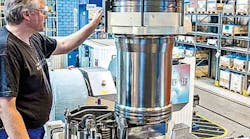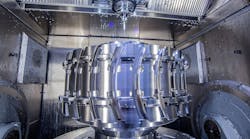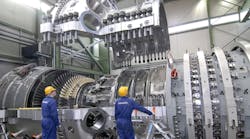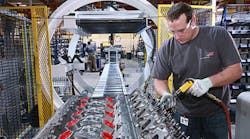Rolls-Royce introduced a new family of medium-speed engines for the marine market that will be available for diesel and gas fuel. The developer indicated the new Bergen B33:45 engines will produce 600 kW per cylinder, a 20% increase in power per cylinder, while cutting overall fuel consumption, engine emissions, and lifetime operating costs compared to the current models of its Bergen engines.
The first engine, a diesel-powered B33:45, was unveiled at at the SMM conference and exhibition in Hamburg, a maritime industry trade event.
At the core of the design is a new turbocharger that matches the exhaust system and provides multi-pulse charging, with charge air taken through a two stage intercooler, achieving a high turbo efficiency.
The diesel and the gas engines will share the same modular design, built on a ductile iron block that establishes easier maintenance strategies, and offers a more rigid construction than the current B-Series engine, with vibration levels reduced to 10-11 m/sec. The block supports a balanced crankshaft that is the same for both propulsion and generator applications. The cylinders are individual units that can be removed within a service height of 2.52 m above the crankshaft centerline. Three-piece connecting rods allow piston removal without disturbing end bearings. The strengthened camshaft design has one section per cylinder, again to simplify replacement.
In addition, the external pipework has been reduced from the current standard, for a safer and simpler fuel system. The oil bores have been designed into the cylinder heads and the passages are joined by transfer blocks.
The B33:45 meets IMO Tier III NOx emission requirements thanks to a selective catalytic reactor (SCR), which uses urea to convert the NOx into nitrogen and water vapor. Using SCR technology, NOx levels within IMO levels have been validated from 10 to 100% load. The control unit is integrated into the engine controller and compact SCR units will come in various sizes to match a user’s selected engine power.
"Ship owners want better performance at a lower price and society wants cleaner oceans. This new family of engines will deliver what our customers need in terms of cost and the environment,” noted Mikael Makinen, president of Rolls-Royce Marine.
"We have been developing this engine over the past three years, and part of its future success will be down to the excellent collaboration and sharing of engine technology between our experts in Bergen, Norway and Friedrichshafen, Germany.
"Our Bergen engine range is renowned for its robust design and reliability, and this completely new modular engine architecture not only builds and improves on our existing capability, but gives us an engine family that is truly engineered for the future, with numerous configurations and multiple fuel options. It fits perfectly with our vision of providing better power for a changing world."
The B33:45 in-line engine platform will consist of 6, 7, 8 and 9-cylinder variants spanning a power range from 3,600 kW to 5,400 kW. A V-engine range will be introduced in the future, with a range of incremental power for the marine and land-based power plant market.
The engines are suitable for various offshore vessels, including anchor handlers, seismic, subsea construction vessels, semi submersibles, and drill ships. It also will be available for commercial vessels, such as ropax ferries, cruise, cargo ships, and fishing vessels.
The first B33:45 will be delivered in June 2015 to Prestfjord Havfiske AS, for a new Rolls-Royce designed fishing vessel.










